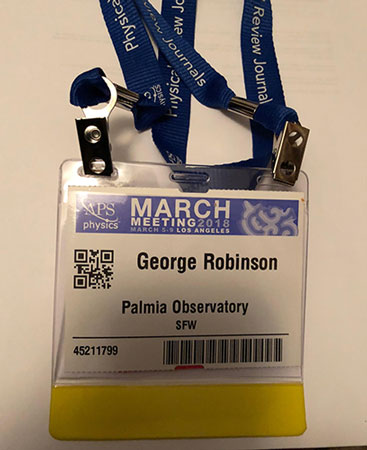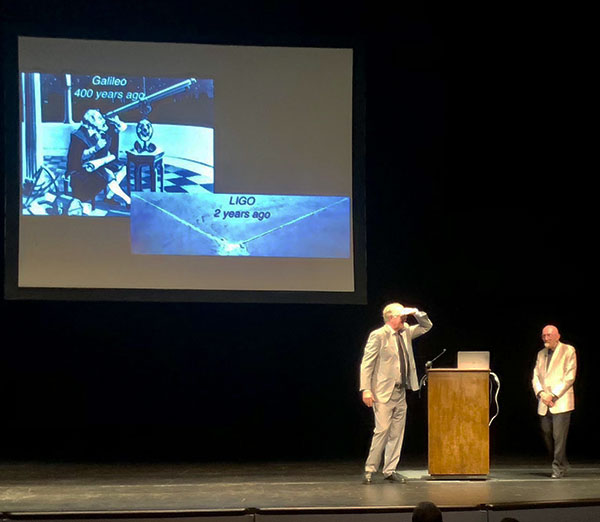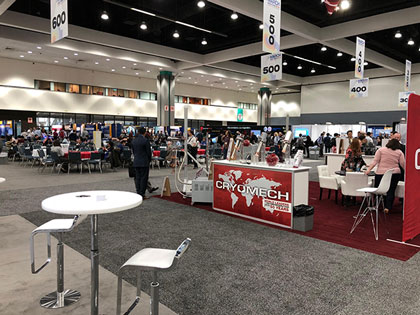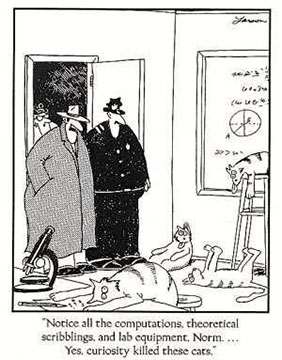Greetings from Palmia Observatory
Well this week and upcoming forecast shows just clouds and clouds and more clouds with some rain, so keep your scopes indoors and dry. Luckily, I have been at the American Physical Society March meeting for most of this week. So this post covers some follow up analysis of Airy rings, summary comments from APS March meeting and UCI Physical Sciences lecture by Kip Thorne and a warning for Astronomer Assistant Willow. So,
lets get started with some analysis of the Airy ring photo, using Sirius as the target source, presented last week.
The magnified image below shows my guess measurement of the first Airy ring being about 26 pixels, where each DSLR pixel is about 4.3 x 4.3 microns. Physical optics theory predicts Airy ring radius to be approximately equal to 1.22 x wavelength x focal length divided by diameter of the lens. So assuming wavelength in the middle of the optical range as say 550 nm, and 300mm lens focal length and f/45, we can estimate the predicted diameter to be 2 * 1.22 * 550 * 45 = 60 microns, or about 60 / 4.3 = 14 pixels.
Ok, the prediction does not match the measurement, so something is a bit off. I probably overestimated the diameter and there might be some hidden feature in Photoshop that I have not set properly. Anyway, that is the first measurement made of the Airy ring using this image of Sirius.
| Measuring the diameter of Airy disk from 300mm, f/45 DSLR image of Sirius (Source: Palmia Observatory) |
One way of getting a better diameter estimate is to decrease the size of the lens aperture. With f/45 the lens aperture would be about 300 / 45 = 6.6mm and if we used smaller lens aperture then the Airy ring diameter would have been bigger. Unfortunately, my DSLR cannot go down any smaller than f/45. But, Moved to the Mountains for Better Viewing, David, sent a note describing how an early edition of Sky and Telescope Magazine described how one could use old lens covers and drill a hole in them in order to do this type of experiment. Hey, I could probably do that and with say a 2.2mm drill hole, would get about three times larger Airy ring diameter, but needing about 3 * 3 = 9 times longer exposure. O, maybe next time. Anyway, thanks for that tidbit of information, David!
Ok, back to the APS March meeting at the Los Angeles Convention Center. The meeting staff was pretty consciousness of checking for badged attendees, so luckily I had on my badge.
 |
| Ok, with this badge I can sit in on the APS March Meeting (Source: Palmia Observatory) |
Now as readers of this blog know my interests lie more in accord with the APS April meeting, which emphasizes physics topics like astrophysics, astronomy, cosmology and gravity studies. But given that the March meeting, which emphasizes atomic physics, condensed matter physics and quantum mechanical fundamentals, was held here locally in Los Angeles, well, I just took a chance and attended the March meeting.
Many of the sessions were way beyond my interest or understanding, but I will provide some brief comments on a few of the topics of the sessions that I attended. I attended mostly sessions dealing with big data and deep learning, history of physics, foundations of quantum mechanics, and careers in physics, and didn't get much into those sessions on condensed matter physics.
Big data and deep learning and artificial intelligence is playing a large role in analysis of experimental data now. There is so much data being gathered and so few eyeballs, from graduate students or others, to look at it and make sense of it, so machine learning and analysis is getting a lot of attention. Many of these deep learning applications can produce good analysis and results but it is not always clear what the machine has done to reach its conclusions. The fanciful case of correlation, shown in the image below, identifies the well known problem that correlation does not necessarily mean causation. In fact the correlates might both have a cause in common for instance.
There are now so many deep learning took kits freely available for Mathematica and Python that I hope to be able to play around with this stuff too. Astronomers too are going to be faced with large amounts of data once these large telescopes now under construction come on line and are able to scan the entire night sky every night. These surveys will be so huge that doing the analysis by hand and eyeball will not be possible.
 |
| Neil Johnson, U of Miami, warns of problems in "Big Data" analysis |
As luck would have it, the Kip Thorne lecture at UCI occurred at the same time as I was in Los Angeles, so I had to make the hour and half slog over freeway traffic back to hear him. At least leaving earlier than normal, cut the drive time from 2 hours to just 1.5 hours and allowed me to meet up with Telescope Packed Up in the Garage, Frank, and have dinner and hear all of the gossip about management changes at the old company and all of the other old worker bee friends and associates still there. It was also nice to bump into so many members from our little local science squad of physicist wannabes. Good to see everyone!
Kip Thorne made a fantastic and interesting lecture on the development of LIGO and how he participated in much of the development over 50 years until its recent success. He talked about the uphill battle to keep the LIGO project financed and how many different problems had to be solved along the way. He said that with the LIGO gravitational wave detection two years ago, astronomers are now in this new era of multi-messenger astronomy with as many discoveries to be made as those since the time of Galileo 400 years ago. Some of his recent work in orbits of small black holes around supermassive black holes was especially interesting in that he described how they now can simulate such motion and find it to be especially chaotic, not Keplerian like we supposed it would be due to the highly distorted spacetime around the massive black hole.
 |
| UCI Dean Janda looks for questions following Nobel laureate Kip Thorne presentation |
Now, back in Los Angeles, one of the other three LIGO prize winners, Barry Barish, Caltech, was one of the Kavli Institute sponsored speakers and he described his experiences on the project. He was very responsible for herding the team of almost 2000 physicist cats and keeping them on track to the successful completion of LIGO. He described the planned two pronged approach to first building the installations, which would not likely have enough sensitivity, but would enable working out all of the details, so that when the advanced system was installed, the required sensitivity would be realized.
 |
Nobel laureate Barry Barish speaks about LIGO at APS March meeting
|
Some of the other Kavli presenters talked about a wide range of topics including a $2.50 microscope that could be hand constructed, Orgami style, by third world students, who would otherwise not be able to afford any type of microscope. Another speaker told of his efforts to encourage middle and high school students to maintain an interest in STEM and physics. So many students have a poor experience in their first physics or science class and decide not to continue, but with encouragement this exit need not happen.
One of the sessions I attended was directed towards physics students, which I interpreted to apply to physicist wannabes like myself, but mostly directed towards what job opportunities were possible. Some speakers told of their experience of working at JPL or of transitioning from rocket science to working in the financial industry. One speaker, who I recognized, was CSULB Professor Peterson, who spoke about working in a mainly undergraduate institution like CSULB.
He gave a good description of the working day and how it compared to say a typical much larger research university. There are probably not enough university positions available for all the graduates but positions in industry can often be just as rewarding and probably more financially compensated. He described the tradeoffs that young professors face in trying to keep up with doing some research, doing some community services, teaching some classes and still trying to maintain some balance for a family life too. After his presentation, Math Whiz, Dave, and I were joking that he covered most of the important concerns for young students, but didn't get into what worried us older "senior" students was whether we would live long enough to get through our physics studies! Anyway, enjoyed your presentation, Professor Peterson!
 |
| CSULB Professor Peterson tells all of us physicist wannabes about life in the university |
The APS meeting in addition to various sessions and speakers also had a large conference hall of exhibitors and their products. It was fun just walking around and looking at stuff and trying to find those vendors that were giving away chocolate or wine. Ok, ok, I did actually look at the equipment too!
 |
| Hundreds of institutions and laboratory vendors show up at the APS exhibit hall |
Many retirees get caught up with the idea of a RV that they can drive around to various vacation spots and sort of bring their home with them. This never grabbed my attention much in that I always just wanted to stay in a hotel with a bar where I didn't have to cook or take out the garbage. Anyway, I saw this RV type vehicle at the APS meeting that was just jam packed full of physics laboratory equipment. Hey this sounds like a great thing to have and one can keep all of the lab clutter confined to the vehicle! I walked through it and wow, it was full of a lot of good equipment that I could never find enough space for here at the observatory!
 |
| Now this is my idea of a RV; Full of physics laboratory demonstration equipment |
There were many vendors in the exhibit hall that provided various fixtures and assemblies used in high vacuum instrumentation. Many of these fixtures were made out of shiny titanium and this image of a countertop full of stuff was the closest I was to what is pretty close in the physics world to be called "bling." Wow, pretty!
 |
| Hey, there is some titanium 'bling" for physicists at the APS March meeting |
So, that is my brief summary of my three days at the March APS meeting. Following that meeting, it was again time for the monthly OCA general meeting. This was a very interesting meeting where the presentation by UCLA Professor Ben Zuckerman, whose topic was, "The Search for ETI and why it will fail."
I really enjoyed the presentation and to me he made a compelling argument. The current search for ETI is based on finding and identifying radio signals from the cosmos, but this approach so far has failed. True, the search is just getting started, Zuckerman argued for a different type of search for life, not necessarily intelligent life, based on satellite technology called "terrestrial planet finder." These satellite probes will look for telltale signs in the atmospheres of exoplanets, by occluding the home star and looking only at the planet's atmosphere, where the presence of say oxygen and methane, might indicate the presence of life on that planet. That finding would be based on the out of equilibrium condition of those gases, which normally would be already oxidized and combined with other elements, unless there was a ready source of those gases, which for us is assumed to be caused by life. The other assumption is of course that extra terrestrial life is based on something like the same chemistry as found here on Earth.
He went on to say that we needn't worry about our electromagnetic radio signals giving away our presence in the galaxy because those signals have only been present for something like a hundred years, while the presence of oxygen and methane in our atmosphere has been a signal present for 1-2 billion years. Likewise for other planets that have life. The atmospheric signal of life could be present for billions of years and detecting it is now within the proposed capability of the terrestrial planet finder project. Thanks for that great talk, Professor Zuckerman!
Also after the lecture, I got to wondering just how far away radio signals could be detected from remote planets. With some back of the envelope calculations we can get a sense of the distances possible. My radio astronomy textbook says that a good radio telescope can detect signal power down to about a micro Janksy. The units of Jansky represent radio power of 10^-26 watts per square meter. So a micro Jansky is about 10^-32 watts per square meter.
Now how far away can a one watt transmitter be and still be received. Well, let's start with a distance equal to say one lightyear, which is about 9.5 x 10^15 meters. One watt transmitted from that distance would be dimmer by the square of that distance, so it would be about 10^-32 watts, or one micro Jansky, or about at the level that a good radio telescope could just barely hear it. So if some distant ETI were to be transmitting in all directions with about the same power as a modern day radio broadcast station, of say 10,000 to 50,000 watts, we should be able to hear that station at a distance of say 10 light years. If the transmitter were to include a high gain directional antenna, the distance could be increased to say 1000 light years. Now the Milky Way is 100,000 light years across, so we could only hear from distant planets over just a small part of that distance. But if they were to transmit with say 10 million watts of power and a bit more antenna gain, and they were beaming right into our neighborhood, we maybe could hear from ETI say 1 million light years away. So, if interference did not destroy the signal, it seems we should be able to hear from ETI from within the Milky Way. How about from our closest neighbor galaxy, Andromeda, which is 2.5 million light years away? This seems just a bit beyond the range, but maybe with some exotic noise reduction techniques, which are not included here, maybe a beamed signal from Andromeda could be intercepted. Maybe somebody out there can compare my back of the envelope calculations with what various advocates of SETI claim for their range of detection.
Finally, we got a note from Moved to Florida, Bill, who forwarded this cartoon warning about the dangers of curiosity for cats. This was especially relevant for one of the Palmia Observatory staff members, Astronomer Assistant, Willow. Fortunately, she shows no signs of intense curiosity.
 |
| Fortunately, Palmia Observatory Astronomer Assistant Willow shows little sign of intense curiosity |
Until next time,
If you are interested in things astronomical or in astrophysics and cosmology
Check out this blog at www.palmiaobservatory.com

No comments:
Post a Comment